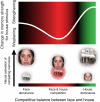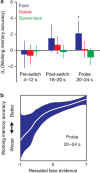Competition between items in working memory leads to forgetting
- PMID: 25519874
- PMCID: PMC4284654
- DOI: 10.1038/ncomms6768
Competition between items in working memory leads to forgetting
Abstract
Switching attention from one thought to the next propels our mental lives forward. However, it is unclear how this thought-juggling affects our ability to remember these thoughts. Here we show that competition between the neural representations of pictures in working memory can impair subsequent recognition of those pictures. We use pattern classifiers to decode functional magnetic resonance imaging (fMRI) data from a retro-cueing task where participants juggle two pictures in working memory. Trial-by-trial fluctuations in neural dynamics are predictive of performance on a surprise recognition memory test: trials that elicit similar levels of classifier evidence for both pictures (indicating close competition) are associated with worse memory performance than trials where participants switch decisively from thinking about one picture to the other. This result is consistent with the non-monotonic plasticity hypothesis, which predicts that close competition can trigger weakening of memories that lose the competition, leading to subsequent forgetting.
Figures





References
-
- Posner M. I. & Cohen Y. inAttention and Performance X: Control of Language Processes eds Bouma H., Bouwhuis D. G. 531–556Taylor & Francis, Inc. (1984).
-
- Posner M. I., Rafal R. D., Choate L. S. & Vaughan J. Inhibition of return: Neural basis and function. Cogn. Neuropsychol. 2, 211–228 (1985).
-
- Mayr U. & Keele S. W. Changing internal constraints on action: the role of backward inhibition. J. Exp. Psychol. Gen. 129, 4–26 (2000). - PubMed
-
- Mayr U. Inhibition of action rules. Psychon. Bull. Rev. 9, 93–99 (2002). - PubMed
Publication types
MeSH terms
Grants and funding
LinkOut - more resources
Full Text Sources
Other Literature Sources
Molecular Biology Databases

